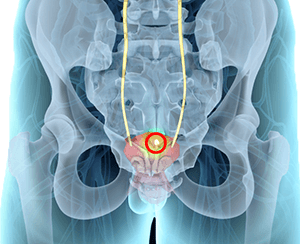
What is Bladder Pain?
Bladder pain is discomfort that originates in the urinary bladder and manifests as pain in the middle part of the lower abdomen, lower back, or groin. The bladder is a hollow, elastic, and muscular organ that expands and contracts while collecting and storing urine from the kidneys before disposal through urination.
Causes of Bladder Pain
Bladder pain may be caused due to numerous factors, which include:
- Urinary tract infection: This condition is mainly caused due to the presence of bacteria in any area of the urinary tract. It most commonly affects women, and when left untreated can cause serious complications.
- Interstitial cystitis: Also known as painful bladder syndrome, it is a chronic condition characterized by painful urination or bladder discomfort without a clear source.
- Bladder cancer: This is the abnormal growth of cells in the muscles, the lining of the bladder, or the innermost layer of the bladder tissue.
- Changes in the reproductive system: This may be due to menopause and includes changes such as thinning of the vaginal skin.
- Prostatitis: This is the enlargement of the prostate gland pressing against the urethra and causing pain and urinary problems.
- Bladder stones: In this condition, the excess minerals in the body concentrate and crystallize to form stones in the urine.
- Urethral stricture (narrowing of the urethra)
- Injury or trauma
- Endometriosis (abnormal growth of tissue on the uterus)
- Congenital defects
- Bowel disorders
Symptoms related to Bladder Pain
Bladder pain can be felt in many different ways:
- Pain with urination
- Pain in the lower abdominal area, rectum, genitals, or pelvis
- Uncomfortable need to urinate frequent
- Pain with sexual intercourse (dyspareunia)
Diagnosis of Bladder Pain
Your doctor will review your medical history and symptoms and based on this a physical examination will be performed. Your doctor may also recommend the following diagnostic tests:
- Urine analysis: Urine samples will be collected and examined for the presence of RBCs, infection, or any other abnormalities.
- Cystoscopy: A long, flexible camera is placed into the bladder through the urethra to visually inspect for signs of irritation, tumors, stones, or other abnormalities that cause discomfort.
- Ultrasound: This study uses high-frequency sound waves to produce images of the bladder tissues and what is inside of your bladder.
- Magnetic Resonance Imaging (MRI) scan: This study uses radio waves and a large magnetic field to produce images of the soft tissues and ligaments.
- Computed Tomography (CT) Scan: This scan uses multiple x-rays to produce detailed cross-sectional images of the bladder.
- Biopsy: This is an image-guided procedure in which a small sample of bladder tissue is taken and observed under the microscope for detecting any abnormal growth.
- Retrograde urethrography: This procedure used an Xray dye injected through the urethra to look for scar tissue or evidence of injury. This procedure only works for men due to the different anatomy of the urethra.
- Hydrodistension: If your doctor suspects your pain results from interstitial cystitis, they may recommend a minor surgical procedure in which the bladder is gently pressurized while you are sedated. This test can both diagnose and treat some forms of interstitial cystitis.
Treatment for Bladder Pain
Treatment measures for bladder pain may vary based on the root cause, this includes:
- Medications: Your doctor may prescribe a combination of antibiotics like nitrofurantoin, amoxicillin, ciprofloxacin which will be provided orally or intravenously to help treat the bacterial infection and relieve bladder pain.
- Urethral dilation or incision of scar tissue: If you have scar tissue narrowing your urethra, opening this scar tissue by gently expanding it or cutting the scar can help reduce your symptoms.
- Bladder instillation: Irrigation of the bladder with various medications has been shown to be effective at managing some forms of bladder pain.
- Lifestyle modifications: Bladder pain can be caused by specific environmental factors. Changes what you put into and on your body can help with symptoms of bladder pain.
- Drink plenty of water
- Reduce intake of soft drinks
- Give up smoking
- Gentle stretching exercises
- Avoid acidic foods
- Avoid perfumed soaps and deodorants
If conservative methods fail to improve the symptoms, surgery will be recommended. The various surgical options include:
- Nerve stimulation: This method uses a small electrical generator implanted in the upper buttocks to create electrical impulses that are passed through the bladder to reduce urinary frequency and relieve pelvic pain.
- Fulguration: This is a minimally invasive method that involves the insertion of instruments through the urethra to burn abnormal growths within the bladder. It can be combined with injection of anti-inflammatory medications into the bladder.
- Bladder Augmentation: Also known as cystoplasty, it is a technique performed to increase the size of the bladder when it is small or stiff as it cannot expand completely to hold the normal amount of urine produced by the kidneys.This procedure is very rarely performed for bladder pain.
- Cystectomy: This process involves the removal of the bladder along with the lymph nodes for the treatment of bladder cancer that has spread to nearby tissue. This procedure is very rarely performed for bladder pain.
